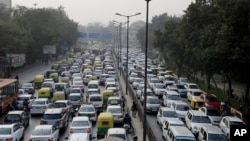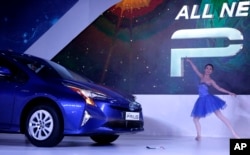At an upscale automobile showroom in New Delhi, Narendra Bhati, whose family is in the real estate business, has just purchased a Toyota Fortuner.
“I am buying it as a gift for my sister’s wedding,” he said. “I, too, have the same car and it is a good one.”
As customers like Bhati boost car sales, global and domestic automakers are posting brisk growth in Asia’s third-largest economy, putting it on track to become the world’s third-largest car market over the next five years.
About 3 million cars were sold in India last year – a 7 percent increase over the previous year. Analysts expect more robust growth this year as rising incomes, falling interest rates and declining fuel prices pull more customers back to car showrooms.
Huge potential
Rakesh Batra, who heads the automotive sector at Ernst & Young consultancy in India, says the potential is still huge.
“Out of emerging markets, India is definitely the bright star because if you look at China, while it is the largest market, growth rates have slowed below India. If you look at Brazil, growth rates are negative. If you look at Russia, similarly growth rates have become negative,” he said.
Optimism has returned after two years – as India faced an economic downturn, car sales declined or remained flat until 2014. That changed last year as the economy picked up momentum, surpassing China’s to become the world’s fastest growing.
Forecasts say India will retain the top slot this year as well.
Wooing customers
That is prompting automakers to woo customers with new launches.
At an auto show in New Delhi, a host of automakers like Hyundai, Ford, Honda and Tata are unveiling about 20 new models -- no-frill, cheap cars and roomier, glitzy sedans and SUV’s to suit the preferences of a more affluent segment.
In a country where car ownership is still a luxury for much of the population, nearly two-thirds of the automobiles sold are in the compact segment.
But tastes are changing with growing incomes, said Sharad Mehra, who owns several car dealerships in and around New Delhi.
“As the aspiration level of the customer is going up, so are the ones who were in the smaller segment, now they want a slightly mid-segment, so the mid-segment is quite looking up,” he said.
The growing potential of the Indian market has already prompted a host of automakers such as Hyundai, Suzuki and Honda to set up large-scale manufacturing facilities in India. Many others plan to follow or expand existing factories to cater to the domestic market and to export to markets like Africa.
Pollution concerns
However, several automakers were taken aback by a recent Supreme Court order that banned the sale of luxury, diesel SUV’s in New Delhi until the end of March.
The order was triggered by concerns over the dangerous levels of air pollution in the Indian capital. But it was a huge setback for many auto companies that have focused on making diesel vehicles, which are popular because diesel costs less than gasoline.
Vishnu Mathur, who heads the Society for Automobile Manufacturers in India, warns that more stable regulations are needed to help the country meet its ambitions of becoming a significant auto manufacturing hub.
“What this industry needs is a long-term road map for growth, whether it is concerning safety, or whether it is concerning emissions or fuel efficiency or whatever you have. If we do not see stability in that, it is going to discourage people from putting in money and investments,” Mathur said.
Despite such hurdles, auto analysts say India will remain a “sweet spot” for the industry as a growing economy propels more of the country’s 1.2 billion people into the middle class.










